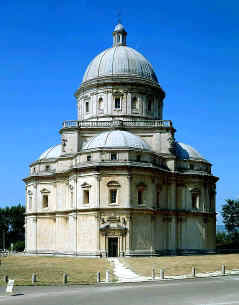Welcome to Todi
From Jesse's Journeys in Italy
Population: 17,075
(2004)
Official website:
Todi
Wikipedia:
Todi
Maps:
MapQuest
Todi sits on two hills high
above the east bank of the
Tiber
at about 470 meters above sea
level. There are three
concentric walls in and around
the old part of the city that
reveal much of its long history.
The innermost walls were built
by its first settlers, the next
ring is a
Roman wall, and the
outermost is medieval.
Todi was settled first in the
8th or 7th Century BC, but
historians are not sure whether
by the
Umbri or
Etruscan people,
although it did become an
important Etruscan city.
In any case, the City was
conquered by the Romans in the
4th Century BC and ultimately
became an important
municipium on the
Via Flaminia.
Rome was eventually conquered by
the
Visigoths who held sway over
the territory, who were
displaced later by succeeding
powers including the
Longobards.
The Longobards were defeated by
Charlemagne, and so there is
even a
Frankish influence in some
aspects of Todi today.
The City also came under the
domination of the
Holy Roman Empire for a
time, but utimately, the City
came to fall securely within the
Papal States, where, except
for a short period during the
Napoleonic conquest, it
remained until
Italian Unification in 1861.
When it was occupied by the
Romans, they quickly replaced
all vestiges of Etruscan
civilization with their own,
building walls, and gates within
the walls (Porta Libera,
Porta Catena, and Porta Aurea),
a theater, an amphitheater, a
Forum, below which were
extensive water cisterns, a
Market, and several temples.
Only fragments remain.
Todi did become a comune like
many other Umbrian cities, then
fell under the rule of a
succession of powerful families
(Signori) who were either
Guelphs (Papal supporters)
or
Ghibellines (supporters of
the Empire). The Guelphs
"won".
During its time
within the Papal States, Todi's
fortunes waxed and waned,
sometimes because of political
or economic difficulties,
sometimes because of plague, and
sometimes a combination of all
three. But, over time,
much was accomplished. The
outer wall and various gates (Porta Romana,
Porta Perugina, Porta
Orvietana and Porta
Amerina) were built,
starting in about 1200.
However, the City achieved it's
greatest triumphs during the
late
Renaissance in the late
16th, early 17th centuries under
the administration of Bishop
Cesi. Many of Todi's
most splendid buildings and
monuments date from this period.
The citizens of Todi, as a
whole, were strongly supportive
of the
Risorgimento,
and in 1849, even hosted
its revolutionary military
leader,
Garibaldi, who was fleeing
from Papal forces.
Todi's main piazza, the
Piazza del Popolo, one of
the most picturesque in
Umbria,
sits on the breast of the lower
hill, and it is here where one
finds most of the principal
medieval and Renaissance
buildings including the Duomo,
the Palazzo del Capitano,
the Palazzo del Priore
and, of course, the Palazzo
del Popolo. Off the
main square there area also a
few Renaissance palazzi, the
most significant of which, the
Palazzo Atti, was built
by the architect,
Vignola. The
church of San Crocefisso
is also of this era.
On the breast of the other hill
are the Church of San Fortuno,
and the ruins of an ancient
medieval fortress. In
other places one will find a
Roman amphitheater, and a Roman
structure built for unknown
purposes which is called the
Niches - or Nicchioni in
Italian.
There are a number of churches,
but perhaps the most beautiful
is the Santa Maria della
Consolazione, a Renaissance
church with a gorgeous dome.
Todi's position on the top of
two high, steep hills gave it a
favorable location in earlier
times, but of course, such a
location mitigates against
economic success in the present
day, when it is more important
to have fast access to major
highways. However, Todi
has managed to create a small
industrial base, and it can
still rely on agriculture in the
surrounding area as a mainstay.
But, without a doubt the most
important "industry" today is
the tourist industry...and for
good reason.
by Vian Andrews September 20th,
2005
|
|
Umbria Region |
|
42°47′N,
12°25′E |
|
Distances |
Spoleto - 44 km
Perugia -
45 km
Assisi - 58 km
Spello - 63 km
Foligno - 73 km
Cortona - 92 km
Gubbio - 94 km
Rome - 131 km
Arezzo - 135 km
Siena - 146 km
Florence - 192 km |
|
Directory |
|
La Colombaia
Apartments |
|

Santa Maria della
Consolazione, Todi |
|

Todi Coat of Arms |
|
The City's Coat of
Arms, adopted in
1200 AD, is an eagle
with eaglets on both
wings representing
its ties with two
nearby cities,
Terni
and Amelia.
The Eagle is
clutching a cloth,
said to represent a
mat upon which
workmen building the
first walls of Todi
had set their lunch. |
|
The poet Jacopone
was born in Todi in
1230. His burial
crypt is in Chiesa
San Fortunato. |
|
An ancient Etruscan
statue, the Marte of
Todi, currently in
the Vatican Museums,
was found near the
walls of the
Cloister of
Montesanto in Todi. |
|
|
|